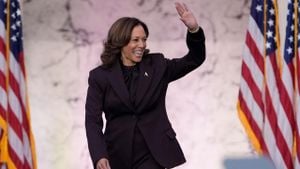Election night unfolded with the vibrant backdrop of America’s political theater. Over the course of those long hours, the echoes of hope mingled with the groans of disappointment as it became clear: Donald Trump, the former president, was set to reclaim his place at the helm of the nation. This election was not merely another chapter; it felt like the culmination of years of political turmoil, shifting alliances, and deep-seated rivalries.
Historically, the 2024 presidential election marked one of the most contentious battles yet. With Trump securing roughly 77 million votes against Vice President Kamala Harris’s nearly 74.5 million, the race highlighted America’s indelible divide. Trump garnered approximately 49.9% of the popular vote, with Harris trailing closely at 48.3%. Meanwhile, voices from alternative parties like the Green Party and the Libertarian Party added layers to the cacophony of dissent.
Commentaries from distinguished strategists pointed out the stark revelations surfacing from exit polls and voter behavior. According to analysis, the Democratic Party faced alarming losses among demographic groups they had once believed would remain steadfast allies. Particularly troubling was the noted shift among working-class voters, including key nonwhite demographics, who swung more significantly toward Trump than anticipated.
Longtime Democratic strategist James Carville articulated this dilemma succinctly during his interview. He expressed concern over the party’s disconnect with working-class sentiments, asserting, “The Democratic Party is simply ‘in the dark’ about how many Americans are getting their information right now.” Carville’s straightforward assessment underscored the need for Democrats to rethink their communication strategies, reaching out beyond traditional bases of support.
Local organizers echoed similar challenges. Julio Cesar Gumeta-Ramos, a community organizer from Milwaukee, offered his insights on the blame placed upon Latino voters for Harris's loss. He shared his experiences and pointed out the significant misunderstanding prevalent among white liberals—falsely attributing Harris's loss to Latino communities, when, in fact, demographic analyses indicated over 50% of Latino men had supported Harris. The rising trend of scapegoat politics continued to display how communities were often unfairly labeled, leading to the urgent need for more grounded narratives.
Delving deeply, polling data from Wisconsin revealed nuances often overlooked. Despite attempts to pin the election loss on Latinos, systemic issues affecting voter turnout were apparent. To Gumeta-Ramos, the structural barriers included persistent underfunding of their communities, evident especially when contrasting with the strategic investments being made elsewhere. “We’re all struggling under high costs of living,” he argued, emphasizing the importance for Democrats to move beyond superficial engagement to genuine economic support.
Examining the broader picture, both Carville and other analysts urged introspection within the Democratic party. The watershed moment was not merely about who the voters chose, but why their choices reflected changing priorities. The stark reality was reflected through the lens of economic conditions—a central point for many households across the Midwest. With stagnant wages stuck at $7.25 for over a decade and rising costs hitting every corner of economic activity, the appeal for policies aimed directly at alleviating economic burdens became apparent.
Looking forward, the democratic infrastructure needed serious reflection and revision. Michael Steele, former chairman of the Republican National Committee, commented on the uncertainty stemming from election outcomes. He likened the Democratic Party’s current predicament to the Republican Party's state of affairs back when he assumed leadership post-2008. “People are asking, not just where the party is going but who is going to lead it moving forward,” Steele emphasized. The demand for fresh leadership and clearer vision echoed throughout discussions among political circles.
The crux of the matter resided not solely within the question of leadership but also within the operational essence of the party itself. For Democrats to regain momentum, they would need to embrace grassroots organizing models and genuinely engage with the concerns of middle America. The focus should pivot away from purely coastal or elite-centric narratives, instead fostering connections deep within the heartland where sentiments of discontent simmered among working-class citizens.
On the ground, evidence of effective grassroots activism persisted. Wisconsin Democrats showcased gains made through relentless community organizing and fair maps campaigns—efforts directed at revolutionizing gerrymandered districts. These successes demonstrated how focused local efforts often translate to more considerable electoral advantages should the party choose to leverage them strategically.
One undeniable conclusion emerged from the 2024 election aftermath; divisive politics fed narratives serving only to balloon divisions and misdirect focus from the actual issues undermining societal progress. Political discussions on both sides—often marred by vitriol—beckoned the parties to take stock of their core missions. Instead of cultivating “blame weed,” both parties needed to gain clarity on how their policies were manifesting on street-level realities.
Steering the Democratic Party toward solutions necessitated comprehension of the emotional and material grievances of everyday Americans. Unless these were front and center, battles for hearts and minds would remain persistently uphill, with future electoral cycles growing increasingly fraught with risks.
On the other hand, indications of continuous support among specific demographics for Trump implied pivotal discussions were necessary around his messaging. Trump’s connection with emotions intertwined with economic anxieties required Democrats to counteract effectively, lest they fall victim to historical cycles of disillusionment.
When viewed through the prism of both local and national scales, the potential for substantive change appeared achievable yet remained heavily reliant on the willingness of party executives to confront uncomfortable truths. Overcoming the obstacles leading to Harris's electoral defeat would necessitate finding common ground. It meant possibly refocusing discussions around immigration and economic welfare, cleverly transcending polarized niches held by each party.
Yet, as the dust began to settle post-election, the sharp memories of the night lingered everywhere. This election was undoubtedly more than the recorded numbers. The sentiments, values, and socio-political disparities underscored America’s need for healing. The opportunity lay not just with one electoral outcome, but with the vibrancy and engagement of all factions of society. Future elections would depend on recognizing the persistent complexity of the American experience—a hallmark of this nation’s reality since inception.
While electoral victory was undeniably significant for Trump, the prevailing spirit was centered more on what this meant for the path forward for both parties. For the Democrats, it was not just about the impending re-election of Trump but equally about cementing their presence as representatives of the working masses. If Democrats and their leaders failed to connect with the very essence of people's struggles, they would find themselves mired deeply within the legacies of their own missteps. The road to redemption for the party required re-learning the importance of empathy—both with working-class realities as well as with their narratives on the campaign trail.
It was yet to be seen how party leadership would respond, but one thing remained sure; the conversations and actions following this consequential electoral night needed to create pathways not only for unity but for genuine and lasting change. With stakeholders stressing the urgency for reforms and redirection, America’s political future remained intriguingly uncertain, yet hopeful.



